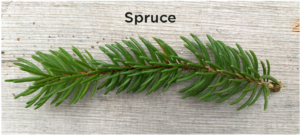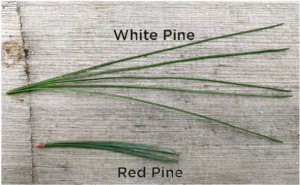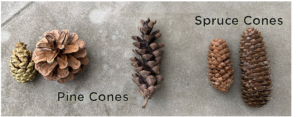By Casey Smith, Naturalist
 “All the leaves are brown. And the sky is gray……” I’ve been for a walk. To identify conifers!
“All the leaves are brown. And the sky is gray……” I’ve been for a walk. To identify conifers!
I’ll admit I’m not good at identifying plants. I have taken to just calling every evergreen a pine tree. And for a Naturalist, I should know better. So, I set about researching the differences in these trees. Let me share with you what I’ve learned!
Conifers are softwood trees that have evergreen needles and produce cones. Ohio is home to six types of native conifers: yew, pine, larch, hemlock, northern white cedar, and red cedar (junipers). Some others including spruce and fir are planted as ornamentals and can be a good indicator of previous areas of settlement. Often confused with each other are the pines, firs, and spruces. With the leaves off the deciduous trees, we can get a better look at these evergreens, so let’s learn how to identify these confusing conifers.
 Notice the needles, it’s the best way to confirm your conifer. Pine tree needles grow in little bundles of two or more joined together where they come out of the branch. These needles are usually softer and longer than other conifers. Red pines grown in clusters of 2, yellow pines in clusters of 3, and white pines in clusters of 5. Spruce needles are short, sharp, and stiff. They grow from a single point, attached to small woody projections. Because spruce needles have multiple sides, they can easily be rolled between the fingers. Fir needles are soft and flat. They grow from a single point but are attached to the branch with something resembling a suction cup. Members of the cypress family, including cedars and junipers, have leaves that are short and scale like.
Notice the needles, it’s the best way to confirm your conifer. Pine tree needles grow in little bundles of two or more joined together where they come out of the branch. These needles are usually softer and longer than other conifers. Red pines grown in clusters of 2, yellow pines in clusters of 3, and white pines in clusters of 5. Spruce needles are short, sharp, and stiff. They grow from a single point, attached to small woody projections. Because spruce needles have multiple sides, they can easily be rolled between the fingers. Fir needles are soft and flat. They grow from a single point but are attached to the branch with something resembling a suction cup. Members of the cypress family, including cedars and junipers, have leaves that are short and scale like.
 Consider the cones. Pine cones usually start green then turn dark brown or black. They are woody and inflexible. On pine trees, cones hang down toward the ground. Cones of a spruce tree also hang toward the ground. They are usually smooth and flexible with thin scales. Fir cones grow upwards like a candle flame and tend to be a golden-brown color. Juniper “berries” are fleshy cones with fused scales.(Fun fact: they make up the principal flavoring in gin.) Yews also produce berry like cones.
Consider the cones. Pine cones usually start green then turn dark brown or black. They are woody and inflexible. On pine trees, cones hang down toward the ground. Cones of a spruce tree also hang toward the ground. They are usually smooth and flexible with thin scales. Fir cones grow upwards like a candle flame and tend to be a golden-brown color. Juniper “berries” are fleshy cones with fused scales.(Fun fact: they make up the principal flavoring in gin.) Yews also produce berry like cones.
Study the silhouette. Pine trees generally grow into a loose triangular pattern. Ask anyone to draw a Christmas tree, and they will give you the perfect silhouette of a spruce. A fir is similarly spruce shaped, but with a little more room between branches.
Using these characteristics, it’s become very easy to distinguish the differences in these trees. We are all constantly learning new things. Learning something new makes us feel better and more confident in ourselves. Take a winter walk and learn something new today!







